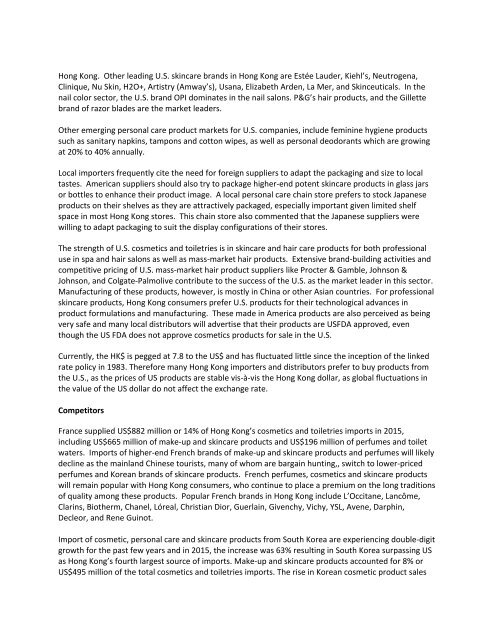Asia Personal Care & Cosmetics Market Guide 2016
AsiaCosmeticsMarketGuide
AsiaCosmeticsMarketGuide
You also want an ePaper? Increase the reach of your titles
YUMPU automatically turns print PDFs into web optimized ePapers that Google loves.
Hong Kong. Other leading U.S. skincare brands in Hong Kong are Estée Lauder, Kiehl’s, Neutrogena,<br />
Clinique, Nu Skin, H2O+, Artistry (Amway’s), Usana, Elizabeth Arden, La Mer, and Skinceuticals. In the<br />
nail color sector, the U.S. brand OPI dominates in the nail salons. P&G’s hair products, and the Gillette<br />
brand of razor blades are the market leaders.<br />
Other emerging personal care product markets for U.S. companies, include feminine hygiene products<br />
such as sanitary napkins, tampons and cotton wipes, as well as personal deodorants which are growing<br />
at 20% to 40% annually.<br />
Local importers frequently cite the need for foreign suppliers to adapt the packaging and size to local<br />
tastes. American suppliers should also try to package higher-end potent skincare products in glass jars<br />
or bottles to enhance their product image. A local personal care chain store prefers to stock Japanese<br />
products on their shelves as they are attractively packaged, especially important given limited shelf<br />
space in most Hong Kong stores. This chain store also commented that the Japanese suppliers were<br />
willing to adapt packaging to suit the display configurations of their stores.<br />
The strength of U.S. cosmetics and toiletries is in skincare and hair care products for both professional<br />
use in spa and hair salons as well as mass-market hair products. Extensive brand-building activities and<br />
competitive pricing of U.S. mass-market hair product suppliers like Procter & Gamble, Johnson &<br />
Johnson, and Colgate-Palmolive contribute to the success of the U.S. as the market leader in this sector.<br />
Manufacturing of these products, however, is mostly in China or other <strong>Asia</strong>n countries. For professional<br />
skincare products, Hong Kong consumers prefer U.S. products for their technological advances in<br />
product formulations and manufacturing. These made in America products are also perceived as being<br />
very safe and many local distributors will advertise that their products are USFDA approved, even<br />
though the US FDA does not approve cosmetics products for sale in the U.S.<br />
Currently, the HK$ is pegged at 7.8 to the US$ and has fluctuated little since the inception of the linked<br />
rate policy in 1983. Therefore many Hong Kong importers and distributors prefer to buy products from<br />
the U.S., as the prices of US products are stable vis-à-vis the Hong Kong dollar, as global fluctuations in<br />
the value of the US dollar do not affect the exchange rate.<br />
Competitors<br />
France supplied US$882 million or 14% of Hong Kong’s cosmetics and toiletries imports in 2015,<br />
including US$665 million of make-up and skincare products and US$196 million of perfumes and toilet<br />
waters. Imports of higher-end French brands of make-up and skincare products and perfumes will likely<br />
decline as the mainland Chinese tourists, many of whom are bargain hunting,, switch to lower-priced<br />
perfumes and Korean brands of skincare products. French perfumes, cosmetics and skincare products<br />
will remain popular with Hong Kong consumers, who continue to place a premium on the long traditions<br />
of quality among these products. Popular French brands in Hong Kong include L’Occitane, Lancôme,<br />
Clarins, Biotherm, Chanel, Lóreal, Christian Dior, Guerlain, Givenchy, Vichy, YSL, Avene, Darphin,<br />
Decleor, and Rene Guinot.<br />
Import of cosmetic, personal care and skincare products from South Korea are experiencing double-digit<br />
growth for the past few years and in 2015, the increase was 63% resulting in South Korea surpassing US<br />
as Hong Kong’s fourth largest source of imports. Make-up and skincare products accounted for 8% or<br />
US$495 million of the total cosmetics and toiletries imports. The rise in Korean cosmetic product sales

















